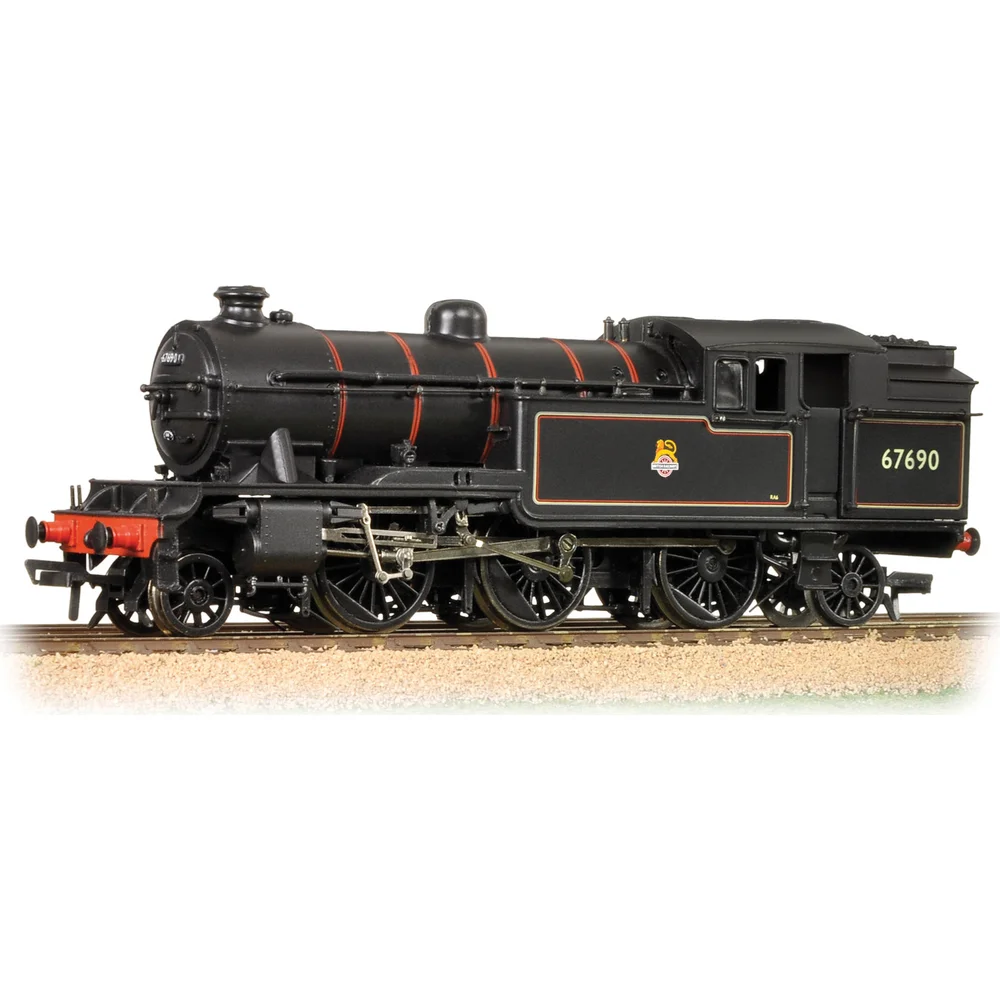Bachmann 31-615
London & North Eastern Railway V3 67690 British Railways Lined Black with Early Emblem
Tooling
In 2016, Bachmann introduced a completely retooled version of the LNER V1/V3 2-6-2T tank locomotive for OO gauge. This upgrade replaced the outdated split-chassis design of the 1990s with a modern, high-specification model that meets contemporary standards for detail, performance, and digital control. The tooling introduced in 2016 remains current, with later releases (including 2022) using the same design.
Tooling Features
- Scale: OO gauge (1:76), 16.5mm track.
- Construction: Highly detailed plastic bodyshell with separately fitted handrails, pipework, and fine rivet detail.
- Detailing: Sprung buffers, accurate cab interior with glazing, and accessory pack for additional detailing.
- Couplings: NEM coupling pockets with tension-lock couplers.
Mechanical & Electrical
- Chassis: Solid metal chassis block for improved weight and stability.
- Motor: Powerful five-pole motor for smooth, quiet running.
- Drive: All driving axles powered via precision gearing.
- Minimum Radius: Recommended 2nd radius (approx. 438mm); some detailing parts require 3rd radius for clearance.
- Lighting: No factory lighting, but provision for decoder-controlled lighting via Next18 interface.
- Weighting: Substantial weight for excellent traction and realistic performance.
DCC Capability
DCC Ready with a Next18 decoder socket and space for a speaker, making sound installation straightforward. Recommended decoder: Bachmann 36-567A or equivalent.
Liveries Produced
- LNER Lined Green (Era 3)
- BR Lined Black with Early Emblem (1949–1957)
- BR Lined Black with Late Crest (1957–1968)
- BR Green with “British Railways” lettering (early BR period)
Reviews & Commentary
The 2016 tooling received positive reviews for its mechanical reliability and improved detailing. While some enthusiasts note that body detail is not quite at the level of the latest premium models, the overall finish and running qualities are highly praised. Key points from reviewers and forums:
- Strengths: Smooth, quiet running; robust chassis; easy DCC and sound installation.
- Critiques: Some moulded details remain slightly heavy compared to newer designs; cab glazing still basic.
Video reviewers often highlight the model’s excellent performance and value for money, calling it “a solid runner with respectable detail.”
Media & Social Media
Popular YouTube channels and forums feature the model frequently. Videos showcase its haulage power, quiet mechanism, and ease of decoder fitting. Social media commentary generally regards the 2016 tooling as a major improvement over the original, bridging the gap between older RTR models and modern standards.
Interesting Notes
- The tooling introduced in 2016 is still in use for current releases, including 2022 variants with updated liveries.
- Accessory packs allow customization for static display or enhanced realism.
Bachmann's Description & Specifications
Featuring a detailed and true-to-prototype bodyshell coupled with a high performance chassis, which is driven by a five pole motor and complete with a Next18 DCC decoder socket and space for a speaker, this model is sure to be popular with LNER enthusiasts and adds another tank engine to the LNER locomotive fleet.
Class & Prototype
- Class: London & North Eastern Railway V3
- Traction: Steam
- Built: 1939-1940
- Total Built: 10
- Running Number: 67690
Operator & Livery
- Operator: British Railways
- Livery: Lined Black with Early Emblem
- Era: 4 - British Railways Early Emblem
British Railways transformed Britain's fragmented rail network into a unified national system following nationalisation on 1st January 1948. Created from the "Big Four" companies under the Transport Act 1947, BR operated most of Great Britain's railways until rebranding as British Rail in 1965, managing over 20,000 route miles and inheriting nearly 20,000 locomotives of diverse designs.
The organisation pioneered standardisation through its revolutionary BR Standard locomotive programme (1951-1960), producing 999 advanced steam engines under Robert Riddles' direction. These included the versatile Britannia Pacifics, mighty 9F freight engines, and mixed-traffic classes that incorporated the best features from all predecessor companies. The 1955 Modernisation Plan accelerated diesel and electric traction development, creating fascinating mixed-traction operations.
Notable achievements included establishing unified locomotive classification systems, introducing distinctive corporate liveries, and managing the complex transition from steam to modern traction. BR's six regional structure preserved operational diversity whilst enabling standardisation of practices, signalling, and rolling stock that had eluded private enterprise for over a century.
The BR era represents steam traction's final flowering alongside emerging diesel technology, creating unparalleled locomotive variety. Today, this heritage remains highly popular with railway enthusiasts through extensive preserved fleets, heritage railway operations, and comprehensive model ranges from manufacturers like Hornby, Bachmann, and Dapol, making BR subjects essential for authentic post-war British railway modelling across all scales.
British Railways' lined black livery was designated for mixed-traffic and secondary passenger locomotives from 1949, following pure LNWR style with black base colour and elaborate red, cream (off-white), and grey lining patterns. The lining specification comprised 5/8" grey, 1/8" cream, 1½" black, and ¼" red bands, with the layout consistent with LNWR practice including deep and shallow valances lined along bottom edges only, unlike green engines. The first lined black engines appeared in August 1948 when Hall 5954 appeared so painted, becoming one of the first to carry the "Lion and Wheel" emblem around the same time.
A wide range of engines was eligible for this livery, from powerful V2s and Counties down to tiny Southern Terriers, encompassing County, Hall, Grange, Manor, Saint, Prairie tanks, and numerous pre-grouping designs of varied shapes and sizes. This created many variations and interpretation problems due to the diverse locomotive types involved, with regional differences in splasher lining treatment—the Eastern Region used red-only splasher lining, whilst the Southern Region evolved from inset to edge lining styles. The emblem was positioned centrally on tender sides above the middle axle box, with the Western Region favouring larger sizes on tenders and bigger tank engines. An interesting period detail saw number plates routinely painted red from late 1949 to early 1952, adding colour contrast to the otherwise black scheme. This livery represented BR's commitment to standardising mixed-traffic operations whilst maintaining the decorative traditions that distinguished passenger-rated locomotives from plain freight engines.
